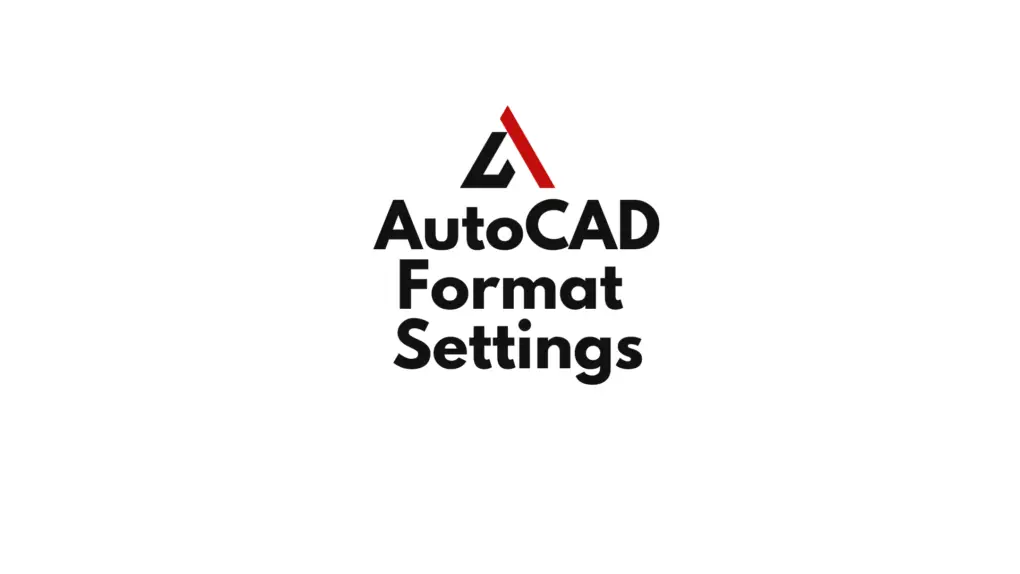Setting up the format for a sheet in AutoCAD is crucial for producing professional architectural and engineering drawings. Proper format settings ensure that your drawings are organized, correctly scaled, and ready for printing or digital submission. Whether you are preparing detailed plans, sections, elevations, or technical drawings, configuring the layout and format settings of your sheet in AutoCAD will directly impact the clarity and readability of your design.
In this guide, we’ll explore how to set up AutoCAD format settings for a sheet, including selecting the correct sheet size, inserting and modifying title blocks, adjusting viewports, and preparing the sheet for printing. Following these steps ensures that your drawings adhere to industry standards and are presented professionally.
Table of Contents
Introduction to Sheet Setup in AutoCAD
The Sheet or Layout tab in AutoCAD acts as a virtual drawing board, allowing you to format and arrange your architectural or engineering drawings for printing or presentation. When working on a project, you typically spend most of your time drafting in Model Space, but once the design is complete, you’ll need to create formatted sheets in Paper Space. This is where format settings come into play.
Why is Sheet Formatting Important?
Correct sheet formatting allows you to:
- Ensure consistency: Maintain uniformity in drawing presentation across multiple sheets.
- Optimize for printing: Ensure drawings are to scale and ready for plotting on standard paper sizes.
- Include necessary information: Incorporate title blocks, project details, and annotations without cluttering the main design.
- Communicate clearly: Provide clear instructions and dimensions to contractors, engineers, or clients through well-organized sheets.
Now, let’s dive into the steps involved in setting up the correct format for a sheet in AutoCAD.

Setting the Correct Sheet Size and Layout in AutoCAD
Creating a New Layout
When you open a new drawing in AutoCAD, you’ll notice tabs at the bottom labeled Layout1, Layout2, etc. These are the default layouts, or sheet setups, provided by AutoCAD. You can customize these layouts or create new ones to fit the specific sheet size required for your project.
- Switch to Layout View: At the bottom of the AutoCAD window, click on any of the Layout tabs. This takes you to Paper Space, where you can set up the sheet format.
- Create a New Layout: Right-click on an existing layout tab and choose New Layout. This will create a blank layout that you can configure according to your needs.
- Open Page Setup Manager: Once your layout is created, right-click the layout tab and select Page Setup Manager. This tool allows you to configure the sheet size, plotter settings, and other important parameters.
Selecting the Sheet Size
Choosing the correct sheet size is essential for ensuring your drawing fits on the paper and is presented at the appropriate scale. Common sheet sizes for architectural and engineering drawings include:
- A0 (1189 x 841 mm) for large project drawings.
- A1 (841 x 594 mm) for detailed floor plans or elevations.
- A2 (594 x 420 mm) for smaller layouts or detailed sections.
- A3 (420 x 297 mm) for smaller design elements, details, or sketches.
In the Page Setup Manager:
- Select Modify under your chosen layout.
- Choose your desired printer/plotter in the Plot Device section.
- In the Paper Size dropdown, select the sheet size that corresponds to your requirements (e.g., ISO A1, ISO A2).
- Adjust the Plot Area to Layout, and make sure the Plot Scale is set to 1:1 (since scaling will be handled within the viewports).
Defining Drawing Scale for Viewports
Once the paper size is set, the next step is ensuring that your drawing fits the sheet at the correct scale. Viewports in AutoCAD allow you to display different parts of your design (e.g., floor plans, sections, or elevations) at different scales.
- Create a Viewport: In your layout, use the MV or MVIEW command to create a viewport.
- Set Viewport Scale: After creating the viewport, select it, and from the Properties panel, set the viewport scale (e.g., 1:100 for a floor plan or 1:20 for a detail section).
- Lock the Viewport Scale: Once you’ve set the correct scale, lock the viewport by selecting it and choosing Lock Viewport from the Properties panel. This prevents accidental scaling changes while navigating within the viewport.
Inserting and Customizing Title Blocks
A title block is an essential component of any architectural or engineering drawing, as it provides vital information about the project, drawing number, date, scale, and designer details. AutoCAD makes it easy to insert and customize title blocks.
Inserting a Standard Title Block
You can either create your own title block or use one of AutoCAD’s built-in templates:
- Insert Command: Use the INSERT command to bring in a title block. If you have a pre-designed block, locate it in your directory, or access a template from AutoCAD’s built-in library.
- Scale the Title Block: Ensure that the title block fits within your sheet size by using the SCALE tool. The title block should align with the borders of the layout without intruding on the drawing area.
- Position the Title Block: Use the MOVE command to position the title block at the bottom or side of your layout, depending on the preferred orientation (landscape or portrait).
Customizing the Title Block
Once inserted, the title block may need to be customized to reflect project-specific information.
- Edit Text Fields: Use the DDEDIT or TEXTEDIT command to modify text fields such as the project name, drawing number, date, and scale. If your title block contains attributes (predefined editable text fields), use the EATTEDIT command to edit these attributes efficiently.
- Add Logos or Graphics: If you need to include a company logo or any other graphics, you can use the IMAGEATTACH command to insert images into your title block.
By customizing the title block, you create a polished, professional look that includes all the necessary project information.
Managing Layers and Line Weights
Proper layer management and the use of line weights are critical when formatting sheets in AutoCAD. Layers allow you to control the visibility, color, and line weight of different drawing elements, making the drawing easier to read and interpret.
Setting Up Layers
- Use the LAYER Command: Open the Layer Properties Manager by typing LAYER in the command line.
- Create New Layers: Add layers for different elements in your drawing, such as walls, dimensions, annotations, or grids. Assign colors and line types to each layer to differentiate between structural, architectural, and annotation elements.
- Adjust Layer Visibility: In Paper Space, you can control which layers are visible in each viewport. Use the LAYFRZ (Layer Freeze) tool to hide unnecessary layers in specific viewports without affecting the overall model.
Applying Line Weights
Line weights control the thickness of lines when printed, helping differentiate between major and minor elements in the drawing. For example, walls and structural elements typically have thicker lines, while dimensions and annotations use thinner lines.
- Assign Line Weights in Layers: Open the Layer Properties Manager and assign appropriate line weights to each layer based on the element’s importance.
- Preview Line Weights: Use the LWDISPLAY command to toggle the display of line weights on or off, allowing you to see how your drawing will appear when printed.
- Override Line Weights in Viewports: If necessary, you can override the default line weights for specific viewports by using viewport-specific layer settings.
Annotating and Dimensioning the Sheet
Annotations and dimensions are essential for explaining your drawings and ensuring that contractors, engineers, and other stakeholders understand the design intent.
Adding Dimensions
To add dimensions to your layout, follow these steps:
- Use the DIM Command: In Paper Space, type DIM or select the dimension tool from the toolbar.
- Click Points on the Viewport: Click on the points in your viewport where you need to add dimensions. AutoCAD will automatically snap to the objects in Model Space, allowing you to add accurate measurements in Paper Space.
- Adjust Text Size and Style: Ensure that the text size and style of the dimensions are suitable for the sheet size and scale. Use the DIMSTYLE command to modify the appearance of dimension text, arrows, and lines.
Adding Text and Labels
Text annotations provide important information about the drawing, such as room names, material specifications, or notes for contractors.
- TEXT or MTEXT Command: Use the TEXT or MTEXT command to add text directly on the sheet. Make sure that the text is placed in a readable location and does not overlap the drawing elements.
- Consistent Text Style: Use a consistent text style throughout the sheet. Set up a text style using the STYLE command, ensuring it matches the required size and font for your project.
Preparing the Sheet for Printing
Once your sheet is set up and formatted, the final step is preparing it for printing or digital submission.
Configuring Plot Settings
- Open Page Setup Manager: Right-click on the layout tab and select Page Setup Manager. Choose Modify to adjust the settings.
- Select Plotter/Printer: Choose the printer or plotter you will use. If you are exporting the sheet as a PDF, select DWG to PDF from the list of plotters.
- Adjust Plot Style: Choose a Plot Style Table to control the appearance of colors and line weights. If you are printing in black and white, select monochrome.ctb to convert all colors to grayscale.
Plotting and Printing the Sheet
- Plot the Sheet: Use the PLOT command to open the plot dialog box.
- Preview the Plot: Always preview the plot to ensure that everything fits correctly on the sheet and that all elements are visible.
- Print or Save as PDF: Once satisfied with the preview, proceed to print the sheet or save it as a PDF for digital sharing.
FAQs
What are the typical sheet sizes used in AutoCAD for architectural drawings?
Common sheet sizes for architectural drawings include A0 (1189 x 841 mm), A1 (841 x 594 mm), A2 (594 x 420 mm), and A3 (420 x 297 mm). The size depends on the complexity and scale of the drawing.
How do I set the scale for a drawing in AutoCAD layout?
Use the MVIEW command to create a viewport and then adjust the scale through the Properties panel or the viewport scale dropdown. Lock the viewport once the correct scale is set to prevent accidental changes.
How do I insert a title block in AutoCAD?
Use the INSERT command to bring in a pre-designed title block. You can scale and move the title block to fit within the layout’s boundaries, and use the TEXT or EATTEDIT commands to modify project-specific information.
What is the purpose of a plot style in AutoCAD?
A plot style controls the appearance of the drawing when printed. It defines line weights, colors, and whether elements are printed in color or grayscale.
Can I print a sheet as a PDF in AutoCAD?
Yes, you can print a sheet as a PDF by selecting DWG to PDF as the plotter in the Page Setup Manager. This creates a high-quality PDF version of your layout, ready for digital distribution.
How do I preview the layout before printing in AutoCAD?
Use the PLOT command to access the plot dialog box, then click the Preview button to see how the sheet will look when printed.

